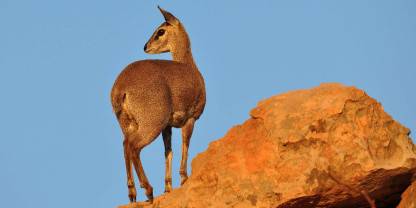Mapungubwe is a UNESCO World Heritage site and has both cultural and environmental significance. Although wildlife is not as much of a highlight as in other parks, the scenery is spectacular, and Mapungubwe Hill is the site of an ancient civilization. Elephant, white rhino and several antelope species are regularly spotted.

-
Best Time To Go
- May to September (Winter)
-
High Season
- Never (The park never gets busy)
-
Size
- 280km² / 108mi²
-
Altitude
-
511-614m /1,677-2,014ft
 View Photos
View Photos
 View Photos
+24
Photos
View Photos
+24
Photos
 Open Map
Open Map
Pros & Cons
- Beautiful scenery
- Visit to the 'Lost City' from the Iron Age available
- Stunning museum and interpretive center
- Excellent viewpoints into surrounding countries
- Great birding facilities including a treetop walk and hide
- Good self-catering accommodation for self-drive visitors
- Off-the-beaten-track destination
- Cultural tour and night drive available
- No high-end accommodation available in the park
Wildlife
Mapungubwe is home to four of the Big Five (buffalo absent). Lion have been spotted, but they are nomadic and only occasionally visit the area from neighboring Botswana. Although leopard is quite common, sightings of these elusive big cats are rare. Elephant, giraffe, white rhino, eland, gemsbok and numerous other antelope species can be seen.
More about Mapungubwe’s wildlifeScenery
Mapungubwe’s dramatic landscape is dominated by big sandstone formations. The arid environment is home to a surprisingly large variety of trees. There are at least 24 species of acacia, but it is the enormous baobab trees that steal the show. One of the highlights in the park is the viewpoint over the confluence of the Limpopo and Shahe rivers – the place where three countries meet: South Africa, Botswana and Zimbabwe.
Weather & Climate
Mapungubwe goes on the boil in the middle of summer (October to April), when daytime temperatures can soar to 45°C/113°F. Summer is also the Wet season in the park, though the rainfall can be sporadic and rarely lasts a full day. The Dry season or winter (May to September) sees clear, warm days followed by cold nights.
More about the weather and climateBest Time To Visit
Try to visit Mapungubwe in the first few months of the Dry season, which stretches from May to September. By this time the heat and precipitation of the Wet season (October to April) has gone, but the chilly nights of the later drier months are yet to arrive.
More about the best time to visit
